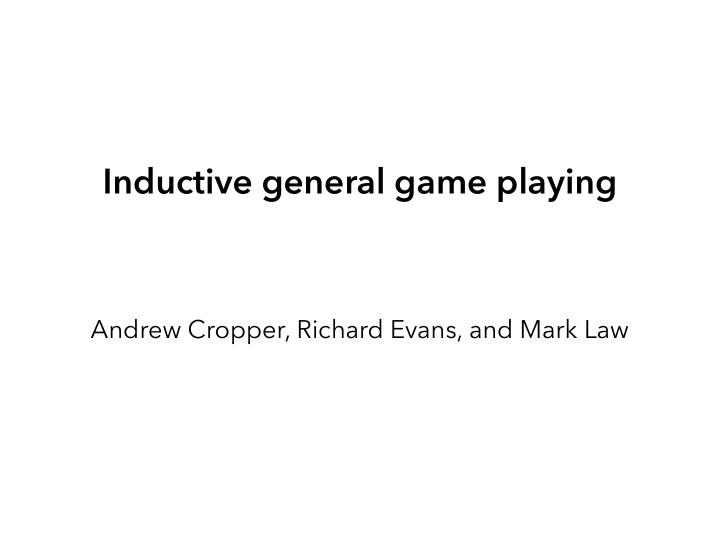



Inductive general game playing Andrew Cropper, Richard Evans, and Mark Law
Inverse general game playing Andrew Cropper, Richard Evans, and Mark Law
Inducing game rules Andrew Cropper, Richard Evans, and Mark Law
General game playing competition
Game description language • initial game state • legal moves • how moves update the game state • how the game terminates
Game description language ( succ 0 1) ( succ 1 2) ( succ 2 3) ( beats scissors paper) ( beats paper stone) ( beats stone scissors) (<= ( next ( step ?n)) ( true ( step ?m)) ( succ ?m ?n)) (<= ( next ( score ?p ?n)) ( true ( score ?p ?n)) ( draws ?p)) (<= ( next ( score ?p ?n)) ( true ( score ?p ?n)) ( loses ?p)) (<= ( next ( score ?p ?n)) ( true ( score ?p ?n2)) ( succ ?n2 ?n) ( wins ?p)) (<= ( draws ?p) ( does ?p ?a) ( does ?q ?a) ( distinct ?p ?q)) (<= ( wins ?p) ( does ?p ?a1) ( does ?q ?a2) ( distinct ?p ?q) ( beats ?a1 ?a2)) (<= ( loses ?p) ( does ?p ?a1) ( does ?q ?a2) ( distinct ?p ?q) ( beats ?a2 ?a1))
Our problem Learn rules from observations • goal • legal • next • terminal
Why? Many diverse games New games each year
Why? Independent language Not hand-crafted by the system designer Cannot predefine the perfect language bias Focus on the problem, not the representation
Why? Hard problems?
Rock, paper, scissors % BK beats(paper,stone). beats(scissors,paper). beats(stone,scissors). player(p1). % E+ player(p2). next_step(1). succ(0,1). succ(1,2). % E- succ(2,3). next_step(0). does(p1,stone). next_step(2). does(p2,paper). next_step(3). true_score(p1,0). true_score(p2,0). true_step(0).
Rock, paper, scissors next_step(N):- true_step(M), succ(M,N).
Rock, paper, scissors % BK beats(paper,stone). beats(scissors,paper). % E+ beats(stone,scissors). next_score(p1,0). player(p1). next_score(p2,1). player(p2). succ(0,1). % E- succ(1,2). next_score(p2,0). succ(2,3). next_score(p1,1). does(p1,stone). next_score(p1,2). does(p2,paper). next_score(p2,2). true_score(p1,0). next_score(p1,3). true_score(p2,0). next_score(p2,3). true_step(0).
Rock, paper, scissors draws(P):- does(P,A), next_score(P,N):- does(Q,A), true_score(P,N), distinct(P,Q). draws(P). loses(P):- next_score(P,N):- does(P,A1), true_score(P,N), does(Q,A2), loses(P). distinct(P,Q), next_score(P,N2):- beats(A2,A1). true_score(P,N1), wins(P):- succ(N2,N1), does(P,A1), wins(P). does(Q,A2), distinct(P,Q), beats(A1,A2). *draws/1, loses/1, wins/1 not provided as BK!
Fizzbuzz BK divisible(12,1). less_than(0,1). divisible(12,2). less_than(0,2). ... ... divisible(12,12). less_than(30, 31). input_say(player,1). minus(1,1,0). input_say(player,2). minus(2,1,1). ... ... input_say(player,30). minus(31,31,0). input_say(player,fizz). positive_int(1). input_say(player,buzz). positive_int(2). input_say(player,fizzbuzz). ... role(player). positive_int(31). int(0). succ(0,1). int(1). succ(0,2). ... ... int(31). succ(30,31).
Fizzbuzz next count % BK does_say(player,buzz). true_count(12). % E+ next_count(13). % E- next_count(0). next_count(1). ... next_count(12). next_count(14). ... next_count(31).
Fizzbuzz next count % hypothesis % BK next_count(After):- does_say(player,buzz). true_count(Before), true_count(12). succ(Before,after). % E+ next_count(13). % E- next_count(0). next_count(1). ... next_count(12). next_count(14). ... next_count(31).
Fizzbuzz next success % BK does_say(player,buzz). true_count(4). true_success(3). % E+ next_success(3). % E- next_success(0). next_success(1). next_success(2). next_success(4). ... next_success(31).
Fizzbuzz next success correct:- next_success(After):- true_count(N), correct, divisible(N,15), true_success(Before), does_player_say(fizzbuzz). succ(Before,After). correct:- true_count(N), next_success(A):- divisible(N,3), \+ correct, \+ divisible(N,5), true_success(A). does_player_say(fizz). correct:- correct:- true_count(N), true_count(N), divisible(N,5), \+ divisible(N,5), \+ divisible(N,3), \+ divisible(N,3), does_player_say(buzz). does_player_say(N).
Hard problems?
Balanced accuracy ba = (tp/p + tn/n)/2
Perfectly solved the percentage of tasks that an approach solves with 100% accuracy
Results
Results
Results balanced accuracy
Results perfectly solved
Summary IGGP poses many challenges Systems struggle without perfect language bias
Limitations and future work More metrics More games More systems Better ILP systems
https://github.com/andrewcropper/iggp https://github.com/andrewcropper/mlj19-iggp
Recommend
More recommend